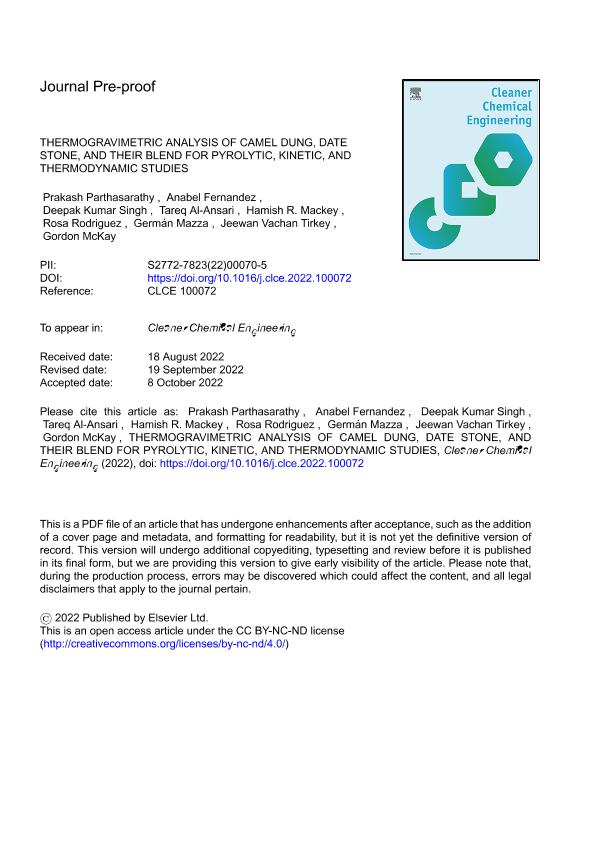Artículo
Thermogravimetric analysis of camel dung, date stone, and their blend for pyrolytic kinetic, and thermodynamic studies
Parthasarathy, Prakash; Fernandez Brizuela, Anabel Alejandra ; Kumar Singh, Deepak; Al Ansari, Tareq; Mackey, Hamish R.; Rodriguez, Rosa Ana
; Kumar Singh, Deepak; Al Ansari, Tareq; Mackey, Hamish R.; Rodriguez, Rosa Ana ; Mazza, German Delfor
; Mazza, German Delfor ; Vachan Tirkey, Jeewan; McKay, Gordon
; Vachan Tirkey, Jeewan; McKay, Gordon
 ; Kumar Singh, Deepak; Al Ansari, Tareq; Mackey, Hamish R.; Rodriguez, Rosa Ana
; Kumar Singh, Deepak; Al Ansari, Tareq; Mackey, Hamish R.; Rodriguez, Rosa Ana ; Mazza, German Delfor
; Mazza, German Delfor ; Vachan Tirkey, Jeewan; McKay, Gordon
; Vachan Tirkey, Jeewan; McKay, Gordon
Fecha de publicación:
10/2022
Editorial:
Elsevier
Revista:
Cleaner Chemical Engineering
ISSN:
2772-7823
Idioma:
Inglés
Tipo de recurso:
Artículo publicado
Clasificación temática:
Resumen
Cameldung (CM) and date stone (DS) are biomass resources that are abundant acrossthe Gulf region and have the potential to produce sustainable renewable fuelsand specialty products. Copyrolysis of camel dung with DS is an intriguingresearch approach to boosting both the production and quality of pyrolysisproducts, particularly biochar. The current study investigated the bio-energypotential of CM, DS, and CD-DS blend by assessing their physicochemical attributes,pyrolysis characteristics, and kinetic behaviour using thermodynamic analysis.To investigate the pyrolysis behaviour, the materials were thermally decomposedusing a thermogravimetric analyser under non-isothermal conditions at differentheating rates in a nitrogen environment. The findings of the physicochemicalanalysis established the bio-energy potential of the feedstocks for long-termenergy generation. Thermal degradation profiles of the samples revealedmultistage degradation due to the various components in their structure. Whilea positive synergistic effect between DS and CD was observed in the thermalprofile of the blend. The average apparent activation energy of CD from theFriedman method, Flynn-Wall-Ozawa (FWO) model, Kissinger-Akahira-Sunose (KAS)method, and Starink model was 324, 167, 157, and 158 kJ/mol, respectively.Friedman, FWO, KAS, and Starink methods yielded average activation energies of621, 315, 276, and 279 kJ/mol for DS, respectively. The mean activation energyof the blend estimated using the Friedman, FWO, KAS, and Starink methods was210, 216, 206, and 207 kJ/mol, respectively. The thermodynamic outcomes revealthat slow pyrolysis of the specified feedstocks is a nonspontaneous processrequiring external energy for their degradation. The findings of this study mayaid in a better understanding of reaction processes and the expansion of pyrolysisapplications of DS, CD, and their mix.
Archivos asociados
Licencia
Identificadores
Colecciones
Articulos(CCT - SAN JUAN)
Articulos de CENTRO CIENTIFICO TECNOLOGICO CONICET - SAN JUAN
Articulos de CENTRO CIENTIFICO TECNOLOGICO CONICET - SAN JUAN
Articulos(PROBIEN)
Articulos de INST. DE INVESTIGACION Y DES. EN ING. DE PROCESOS, BIOTECNOLOGIA Y ENERGIAS ALTERNATIVAS
Articulos de INST. DE INVESTIGACION Y DES. EN ING. DE PROCESOS, BIOTECNOLOGIA Y ENERGIAS ALTERNATIVAS
Citación
Parthasarathy, Prakash; Fernandez Brizuela, Anabel Alejandra; Kumar Singh, Deepak; Al Ansari, Tareq; Mackey, Hamish R.; et al.; Thermogravimetric analysis of camel dung, date stone, and their blend for pyrolytic kinetic, and thermodynamic studies; Elsevier; Cleaner Chemical Engineering; 4; 10-2022; 1-10
Compartir
Altmétricas



